Linking building is a tried and tested practice used over the years to improve the search rank of new and established sites alike.
While there are a bevy of more modern SEO strategies that have evolved since its inception, link building remains as relevant today as it ever was in the past. Here is a quick look at why it is still so widely used.
A good search rank still relies on link building
While lots of factors are taken into account when search engines determine the quality and relevance of pages, the reputation of a site is still largely contingent on the number of high quality inbound links it receives.
This means that if you want to scale to the heady heights of SERPs in an organic and sustainable way, implementing a link building offering is essential to help your websites rank. If you don’t want to handle this yourself, companies like LinkBuilder.io offer a white label solution, which removes the time intensive work required to actually build high quality links to your websites.
Indeed it is increasingly necessary to build a solid link building strategy which nets you the most valuable links on reputable third party sites without falling foul of the ever-watchful search algorithms. There are still plenty of pitfalls to avoid, which is why getting expert assistance makes sense.
[insert page='semrush-vs-ahrefs-which-seo-tool-to-choose-and-why' display='single-related-article.php']
Link building occurs whether you want it to or not
If you run a website then the likelihood is that it will begin to be linked to elsewhere online. While this can be a positive thing so long as the other sites are of a high quality themselves, if you ignore the fact that links of a lower quality exist then you could get penalised even if you are not directly responsible.
As such it is better to be proactive rather than passive about link building so that you can mitigate the risks you face, improve your backlink profile and tackle any troublesome issues which have as yet been left unaddressed.
Organic audience growth can be achieved
The right link on the right site can not only appease search algorithms and boost your rank, but should also bring your brand to the attention of more people.
You will need to pick the right third party sites to achieve this of course, but if your content gets shared in the right context then your site will start to spread by word of mouth, which will also help its overall reputation, search rank and marketability.
[insert page='7-things-you-can-do-to-improve-your-companys-reputation-and-profits' display='single-related-article.php']
Trust can be established
Just as link building can make your site and content more shareable, it can also allow your brand name to get out there and begin to gain traction with the kinds of customers you are hoping to attract.
Given the extent of the security threats that face modern consumers, there is a lot of caution surrounding new brands which have yet to gain the confidence of their prospective fans. The simple act of getting your name out there through link building is crucial to establishing this familiarity that eventually breeds trust.
In short, if you handle link building correctly, it can be one of the best ways to help your business flourish in uncertain times.
Pitching other websites to link to your site can be tough. Your site must be truly unique and exceptionally good to be able to convince other site owners to consent to your request.
However, most people are unaware that there is an easier way to link building. You can do it with Google Alerts. Surprised?
Don’t be because it’s a fact.
Google is the most popular search engine and one with billions of webpages in its database can crawl web pages more frequently than any SEO tool available. By using Google Alerts, you can access this monstrous database to find link building opportunities. The best part is that you don’t have to peer through thousands of pages when you use Google Alerts.
Still wondering how to go about it?
Google Alerts can be used to create notifications on any topic, keyword, or subject. You will get a notification through an email whenever a new webpage with a potential link building opportunity is detected.
This step-by-step guide can help you understand the process better.
Go to https://www.google.com/alerts. You will see this image:
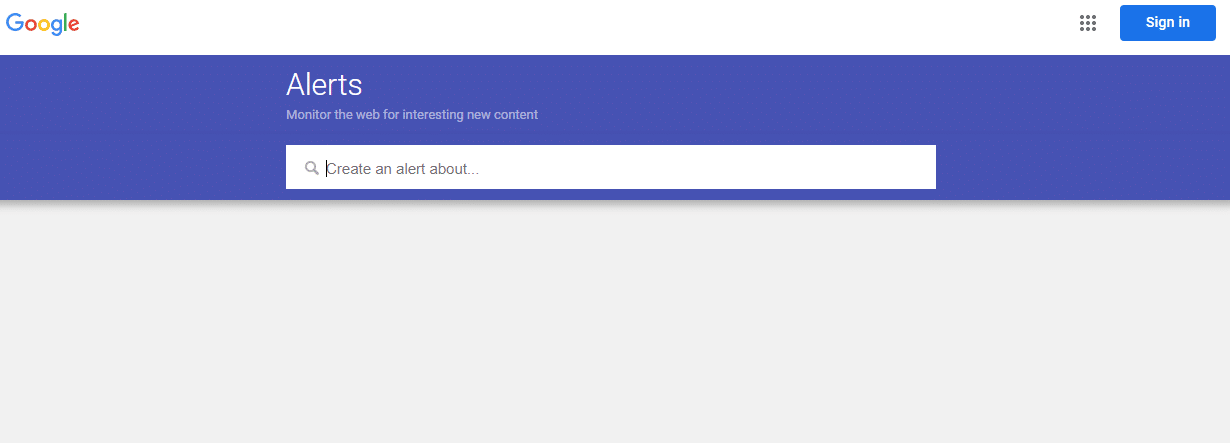
Type your domain name but don’t add the http or the www part of the address. Something like this:

You will see an alert preview that reads:
‘There are no recent results for your search query. Below are the existing results that match your search query.’
This will be followed by several links associated with the query. If your site is a recently launched one, you are unlikely to see any results.
You can explore options with the ‘Show Options’ link placed near the ‘Create Alert’ button. This will provide you with several options.
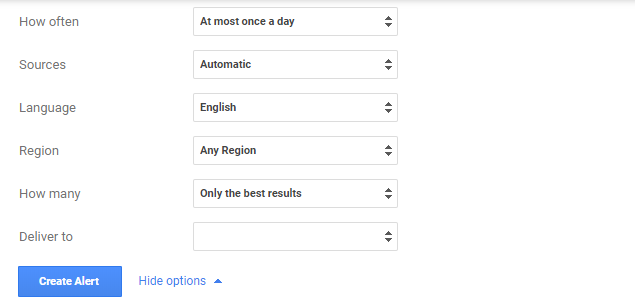
When you keep the settings as mentioned below, you can expect the desired results.
How Often
Once a Day
Sources
The automatic option will create alerts every time the topic or keyword comes up on the web. Choosing two - Blogs, Web is recommended. These two options will ensure that you get the results that best suit your needs. If you choose news, the chances of getting a flood of irrelevant results are more. Besides, the chances of news sites linking to your website are slim.
Language
English is apt unless you are targeting any other language.
Region
You can choose the country you want to target although ‘any region’ is the recommended option.
How Many
The best results will create the best list. You can choose ‘All Results’ because you want access to all possible link building opportunities.
Deliver to
Provide your email address here to receive the alerts.
When you are done with this, click on the ‘Create Alert’ button. You will receive an email with a list of all the pages that mention your website. This list will be sent to your inbox once daily.
You can also create alerts for the following items using the same process.
- Your domain
- Brand name
- Product names
- Email Address
- Industry Terms
Getting In Touch
When you receive the alerts, you will have to contact the site owner through their email. For this, simply visit the contact page and check if the email address is provided. You can also use the contact form to send a message if there is one provided on the site. The Service or Privacy Policy page may also have the contact details of the site owner. There are tools also available that can help you find a contact by simply typing in a domain name.
So, as you have seen and understood by now, Google Alerts provides an easy way of building links.
Unlike other link building options, this one is a time-saver and free of any hassles. You don’t have to go searching for link building opportunities. You will get notified when an opportunity presents itself. That’s the beauty of using Google Alerts.
The social media landscape is becoming increasingly competitive. Small businesses and startups alike can struggle to fend off the might of wealthy and established rivals - which is why it’s vital to invest wisely in time and resources alike.
Luckily, social media marketing can benefit marketers who are willing to work smarter in order to stand out and see tangible results.
As a marketer, it’s vital that you investigate which strategies actually work on different social platforms in order to engage with audiences online. Given the level of competition out there, it’s imperative that companies quickly learn exactly what audiences want to hear from them.
Social media marketing can make small businesses globally visible and can teach marketers a wealth of information about prospective clients and customers alike. Given its clear importance, it’s worth respecting the power of UTM parameters - a tool that’s capable of showing the big picture when it comes to understanding social marketing campaigns.
Understanding Your Urchins
Urchin Tracking Modules (UTM) parameters might sound excessively opaque as a name for the many of us who aren’t blessed with fluency in the world of tech, but they’re actually fairly simple and easy tools to use - regardless of your level of expertise.
UTM parameters exist as short text codes that can be added to links embedded into social media posts, or any text for that matter. They provide plenty of benefits and help users track the value of social marketing programs and campaigns alike. UTMs can also bring marketers accurate data on traffic and where it’s arriving from. They can also help users to conduct A/B tests on individual posts to see which ones are best received among audiences.
Contrary to what some marketers believe, there’s no need to find a programmer to set up UTM parameters or to get them working efficiently on your website and social media profiles. It’s possible to construct the right set of parameters all by yourself.
Fundamentally, UTM parameters are pre-defined text codes that are added to a URL in order to track valuable data pertaining to visitors and traffic sources. For example, here’s a snapshot of a website address with UTM parameters in place:
https://example.com?utm_source=news4&utm_medium=email&utm_campaign=spring-summer
In a nutshell, UTM parameters refer to all text that comes after the question mark (as shown in the URL above. These snippets are valuable to businesses and marketers alike because they work alongside analytics platforms to bring companies a detailed picture of how their social media strategies are performing.
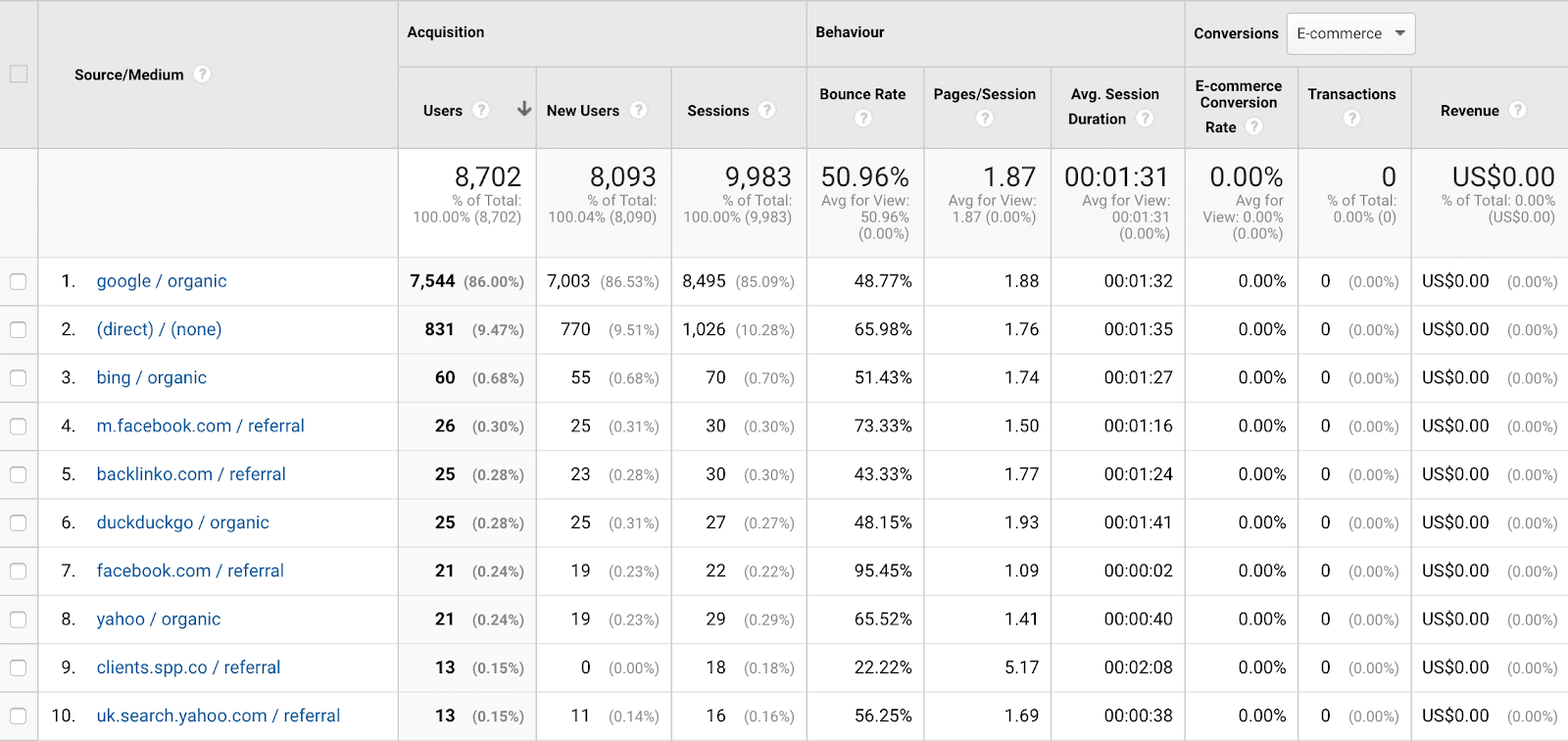
There are five different UTM parameters that can be set. The first three are essential in UTM tracking links, while the latter is exclusively used alongside PPC campaigns.
The first UTM parameter you’ll need to learn relates to your campaign source. This relates to the social network, search engine, backlink, or multimedia link that’s driving the traffic towards your website.
If your campaign has been set up on Instagram, for example, this would be the source. Content campaigns on company blogs and email newsletters can also act as sources.
The sample code for this particular UTM parameter would read utm_source=facebook, for instance.
The next parameter to consider relates to the campaign medium in use. This keeps track of the channel that’s driving the traffic, whether it’s social media, PPC, email, or another source. The sample code for a campaign medium that comes in the form of a Facebook advertising campaign will read utm_medium=fb_ad.
The final organic parameter refers to the campaign name. This is designed so that marketers can keep track of individual campaigns so that they can be better tracked and analyzed.
For example, this would appear in a sample UTM code as something like utm_campaign=signup_offer, and would be tracked differently to parallel campaigns like utm_campaign=spring_sale.
For paid campaigns, it’s possible to set up a UTM parameter that tracks a campaign term. The terms will directly relate to the keywords that you’ve paid to show for and will appear as follows: utm_term=chicago_pizza - provided your chosen keywords included Chicago and pizza.
Finally, the list of UTM parameters is rounded off by campaign content. This particular parameter gives marketers the power to track different advertisements within a campaign. For example, this would appear as something like utm_content=yellow_banner, which would descriptively differentiate from other facets of a paid campaign.
It’s possible to combine multiple parameters together within the same link. Significantly, parameters must come after a question mark, and each one must be separated by an ampersand (&).
Combining all of our sample UTM parameters shown in the previous five points, our final URL would look something like this:
http://www.example.com?utm_source=facebook&utm_medium=fb_ad&utm_campaign=signup_offer&utm_term=chicago_pizza&utm_content=yellow_banner
Looks a little bit clunky, doesn’t it? Not to worry. URLs can be shortened to appear less clumsily thought up.
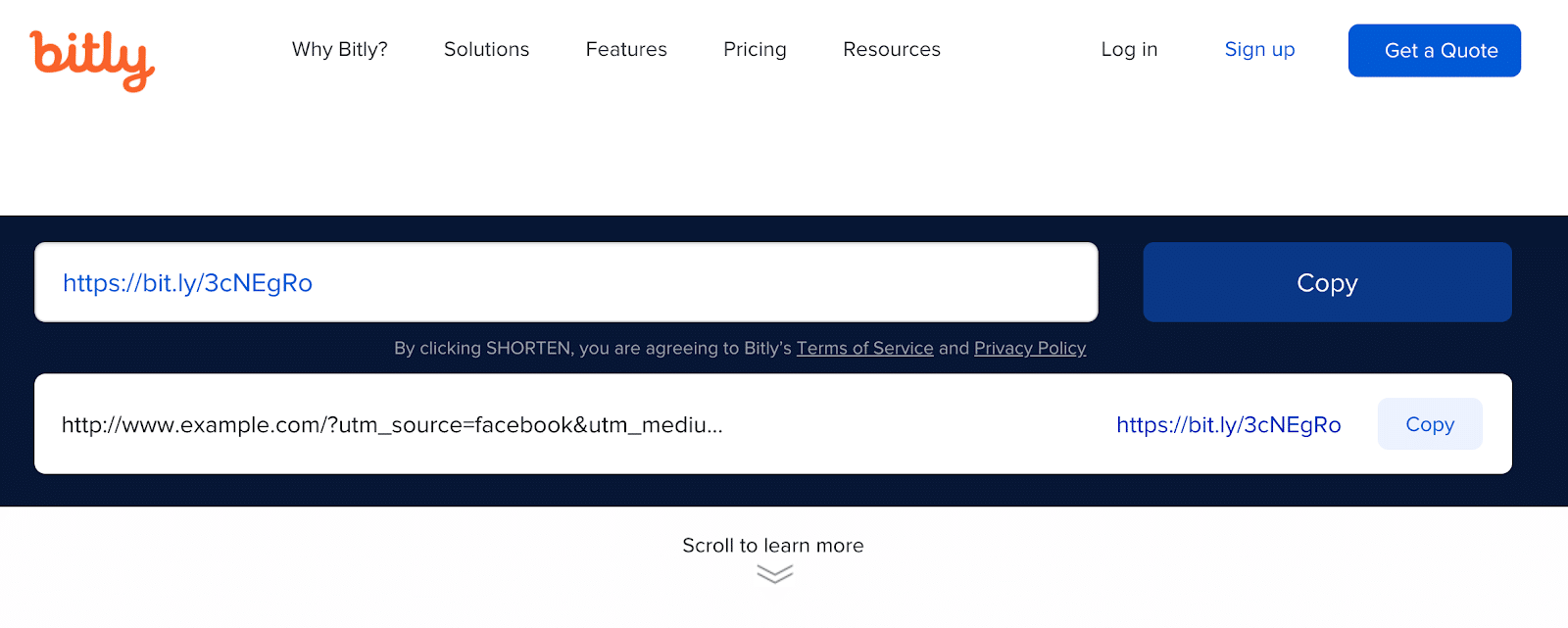
You also don’t need to add these parameters manually. There are plenty of great tools out there that can help automatically generate UTM URLs.
Getting to Grips With UTM Parameters
The most efficient way of setting up UTM parameters is first to make sure you have an account in place with Google Analytics. Using Google Analytics is free - just make sure you specify that the website you’re tracking is indeed your property.
After that, be sure to choose your website’s industry and get yourself a Tracking ID. Finally, copy and paste the global site tag on your website.
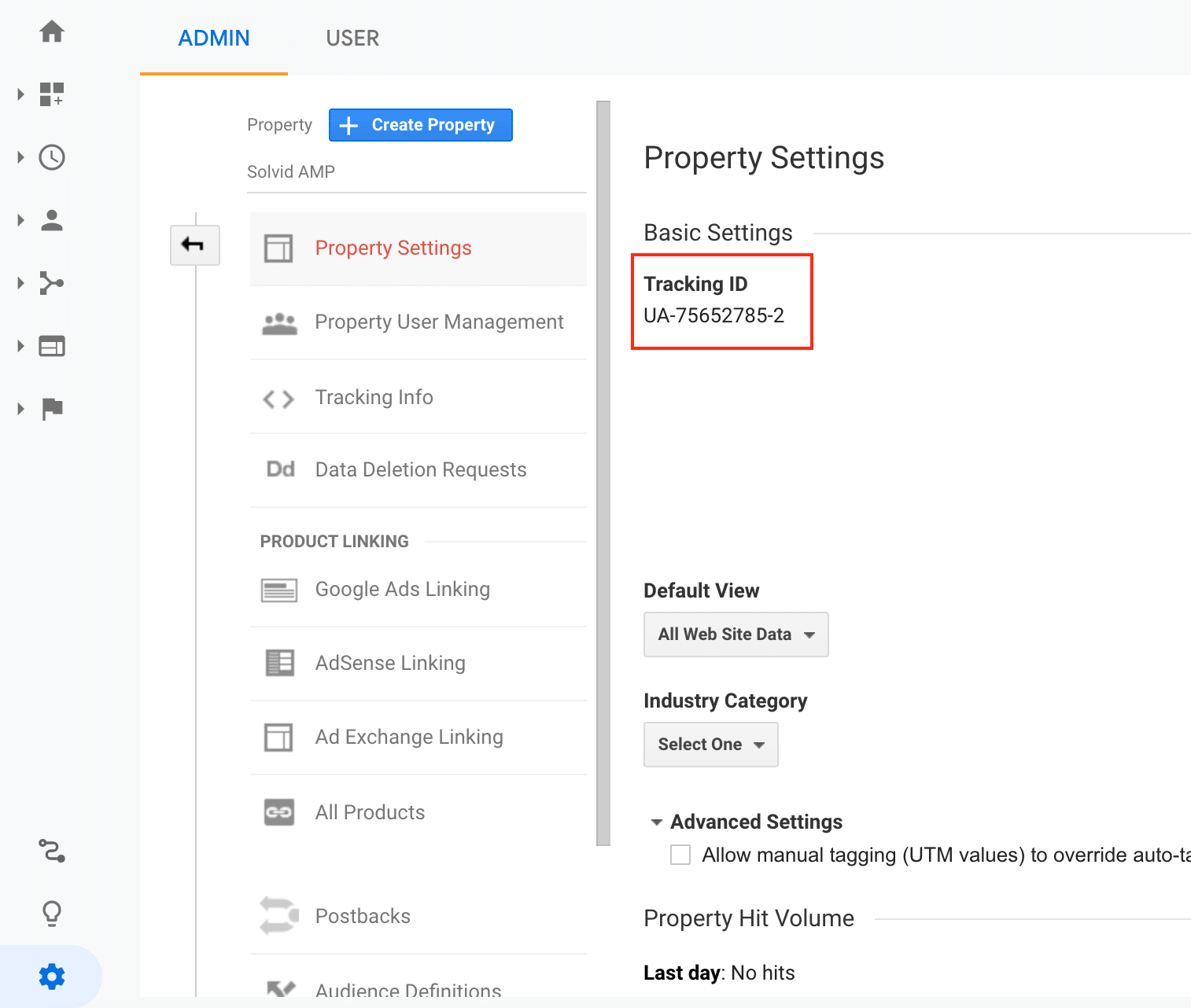
Adding Parameters to Social Media
The brilliance of Google Analytics is that it can be called upon for the majority of the process involved in adding UTM parameters to your URLs. Google Analytics Campaign URL Builder is one of the finest tools online for skyrocketing the performance of social media campaigns.
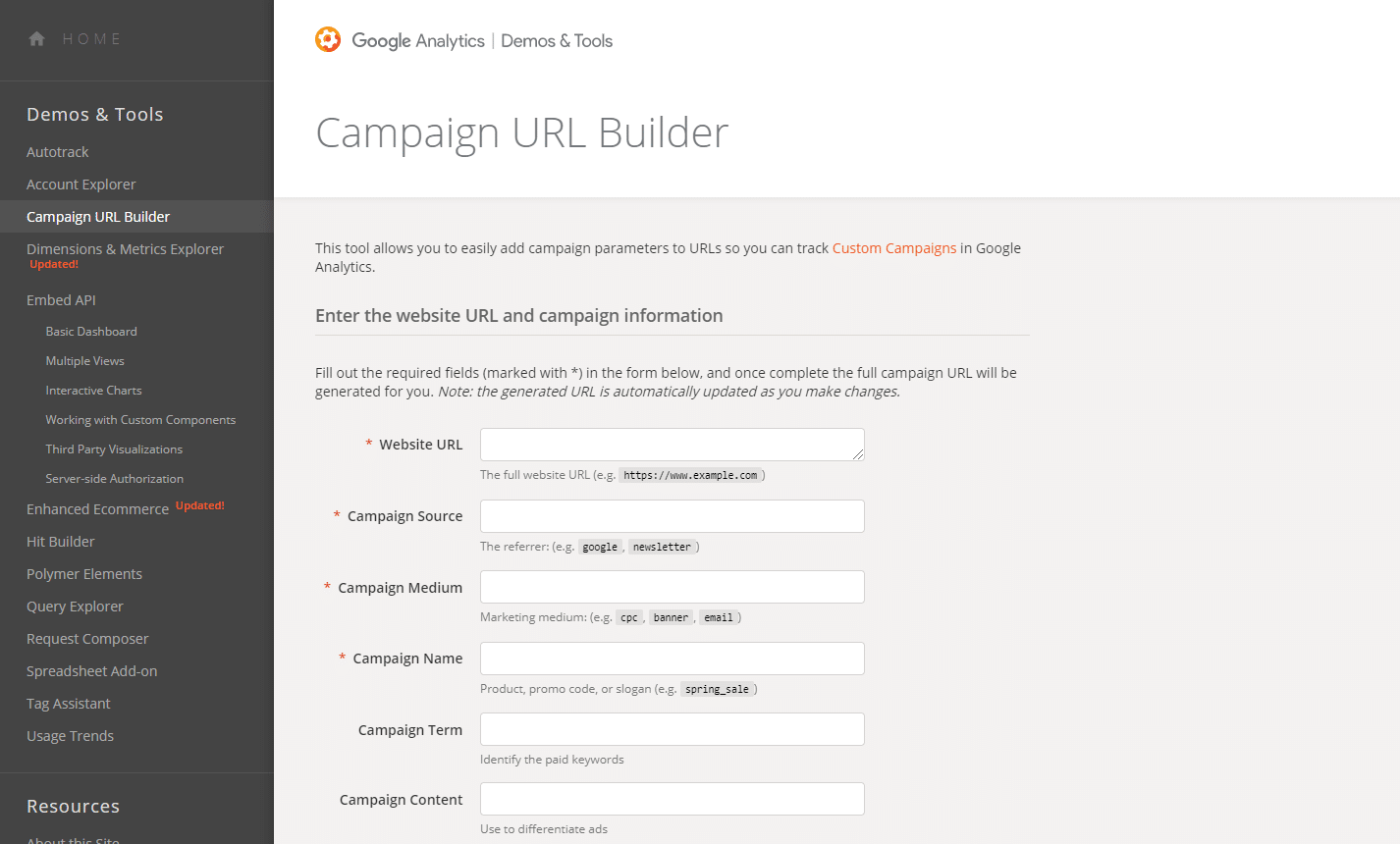
On the Google Analytics Campaign URL Builder, enter the URL of the page you plan on linking to, then fill the relevant fields in with the parameters that you’re intent on tracking.
Once this is done, simply scroll down to find the automatically generated UTM URL. There’s an added option of converting the URL into a much more digestible shorter link. While this option isn’t necessary, it would create more of a manageable and visually appealing alternative.
Finally, you’re free to paste the link onto the relevant social media accounts in order to begin generating relevant clicks.
Tracking and Tracing Your Social Performance
Once your campaigns are set up, return to Google Analytics to monitor their respective progress. This can be done by navigating to the Reports tab before clicking on Acquisition and then Campaigns.
Here, you can access a whole host of different campaigns that have been created with trackable URLs - with easy-to-follow traffic and conversion metrics.
To simplify the process, you can delve into free analytics tools like Finteza, which enable you to filter out social traffic by things like Campaign, Medium, and Term - a pretty handy option.
Simply connect your website and go to Sources > Social.
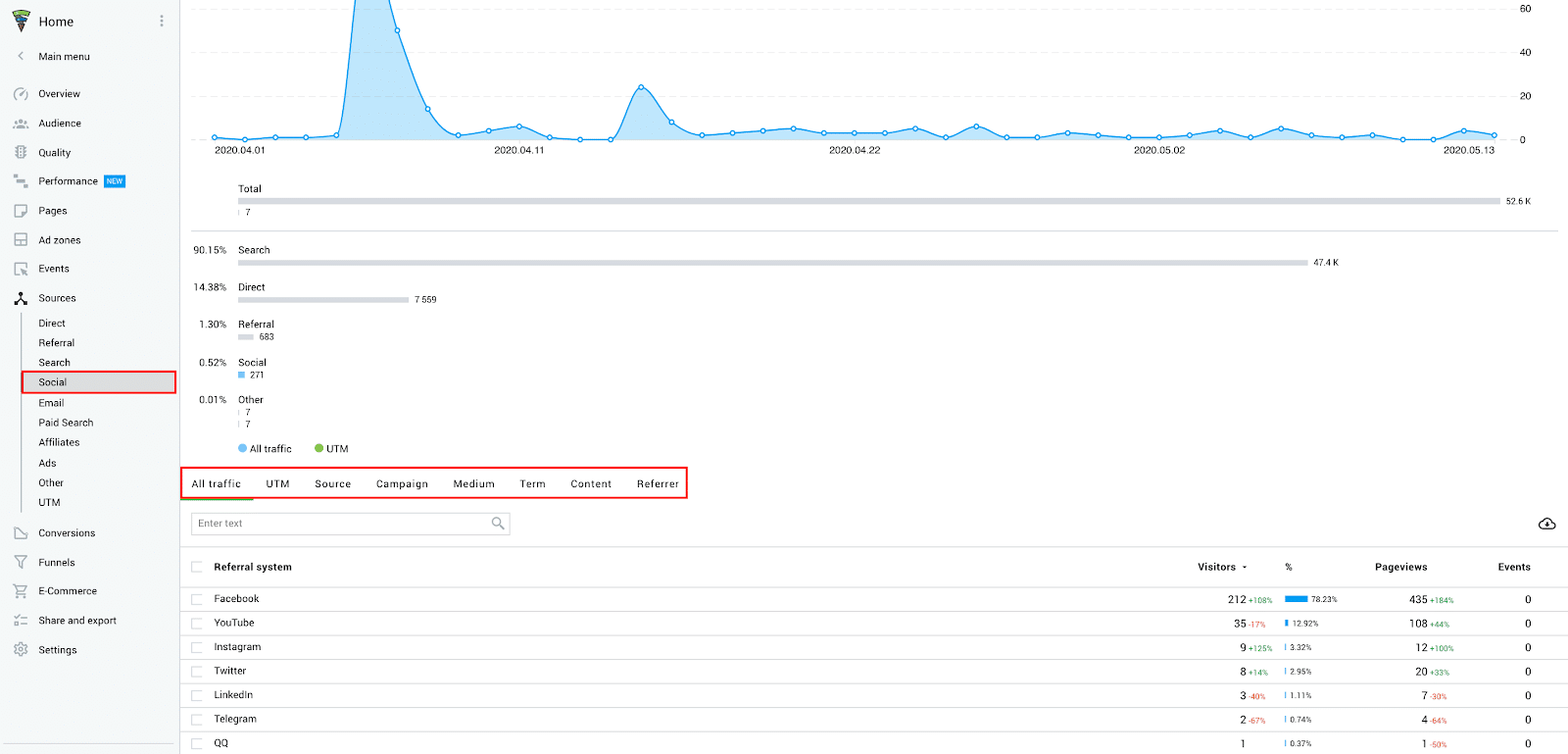
Doing this provides marketers with an unparalleled level of control in monitoring the performance of their campaigns, as well as comparing and contrasting the respective performance of different approaches to social media marketing.
Quality content can reign supreme, whether it’s positioned on a dedicated blog or Facebook account, for instance. However, the high-quality compare and contrast analytics presented through the use of UTM parameters can really allow users to test how varied messages are received online.
UTM parameters can produce a large amount of data, but luckily, the presentation of this data is easy to follow and very actionable. UTM tracking data can be easily exported into PDF, Excel, Google Sheets, and .csv formats for ease of use.
To get the most out of your respective data, it’s important to discuss with other decision-makers in your business what your marketing goals really are. Do you want conversions? Traffic? Or other forms of engagement?
In an online landscape that’s becoming increasingly competitive, UTM parameters may not single-handedly aid you in the battle to overcome your rivals, but they can certainly make all the difference in terms of spending your budget wisely and acting on intelligent insights.
While it’s imperative to resonate with the right audience online, through a combination of Google Analytics and the right set of parameters, it’s possible to forensically measure your ROI while constantly refining your social media strategy in order to only spend money appealing to the right markets at the right time.
If you’re marketing a small business or a startup, spending the same amount of money as your most affluent competitors will be out of the question. But with the adoption of UTM parameters, you can make your campaigns exponentially smarter, and sometimes wise budgeting can make all the difference in outsmarting your rivals.
In the online world, SEO matters. A lot. Talk of SEO tools, SEMrush and Ahrefs rule the roost. Powerful, resourceful, and packed with features, these tools can truly put you in a powerful position online. No guessing game. You know what your keywords are and how they are performing. Who wins the battle of SEMrush vs Ahrefs?
Both platforms offer a series of laudable features. A few are common to both platforms. A few others are exclusive.
So, what to choose?
To come to an intelligent decision, let’s compare the two SEO platforms. However, before we compare, let’s have a glance at both the platforms.
Introduction
SEMrush
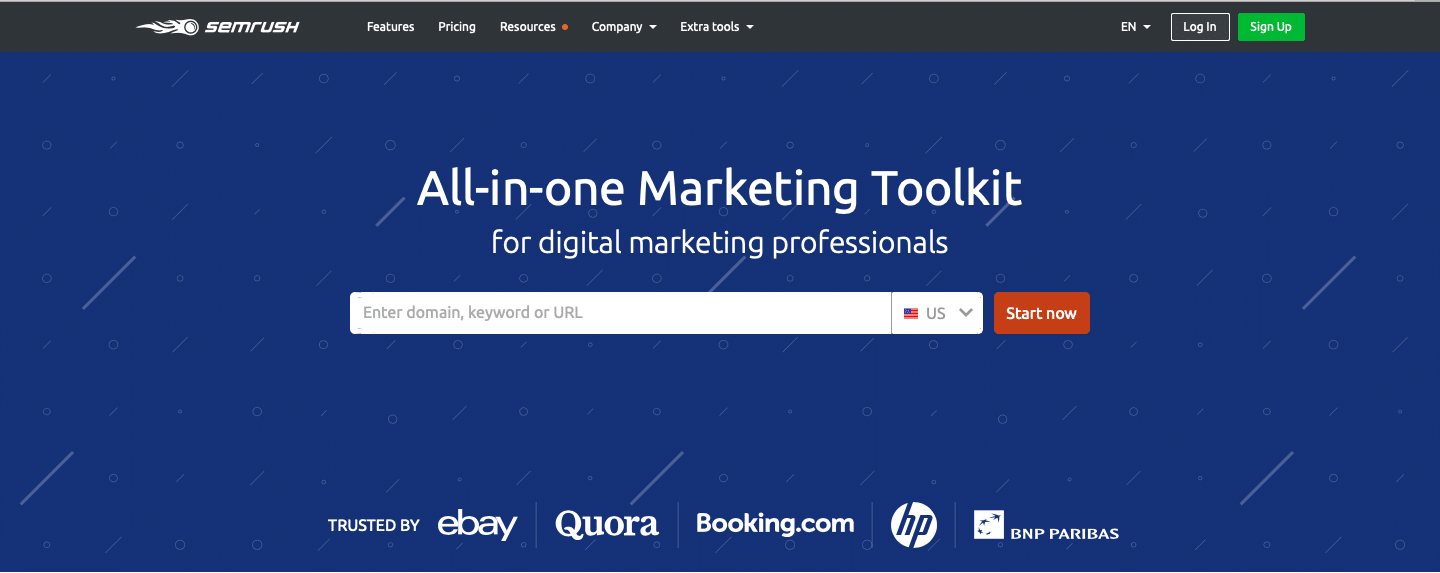
SEMrush was originally SeoQuake, born in 2007. You won’t believe it, but it started as a Firefox extension and, by 2020, became the biggest keyword database available in the market!
The SEMrush Keyword Magic tool contains more than 18.3 billion keywords for the search engine, Google.
It’s one of the most preferred research tools by ambitious digital marketers.
And, by the way, the Firefox extension still exists!
Ahrefs
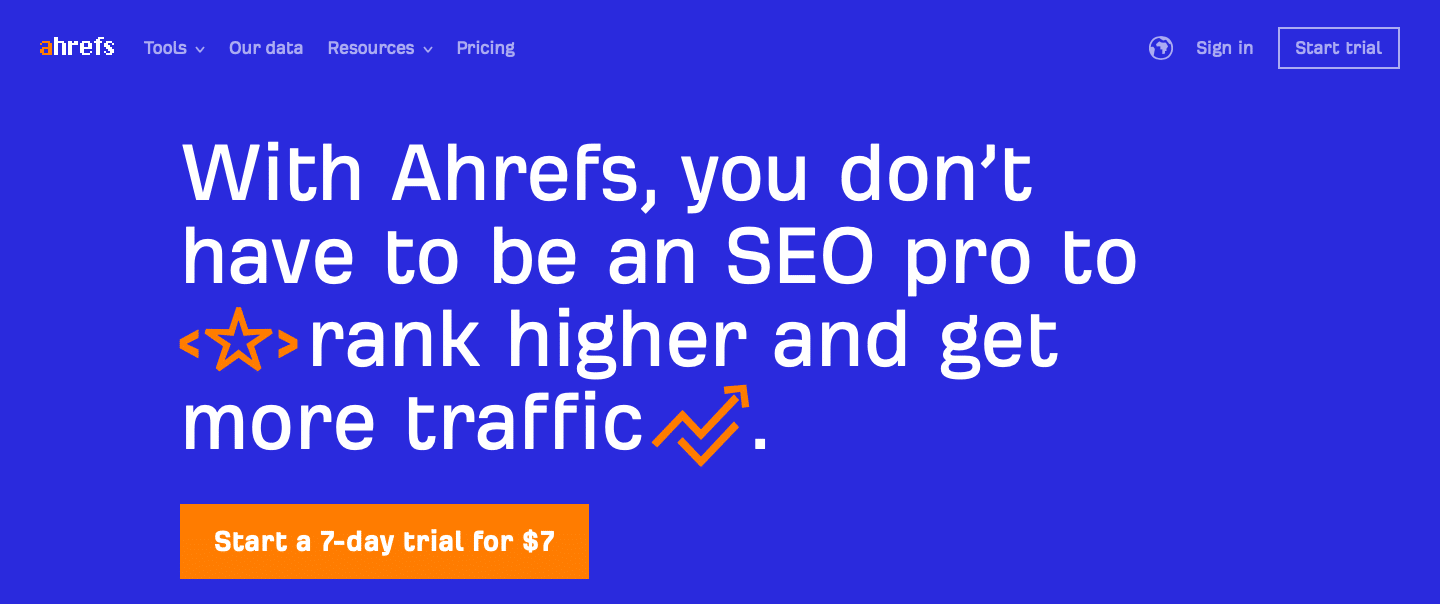
Ahrefs came into existence in 2011. It boasts of an astonishingly accurate link database. Ahrefs has a keyword index of more than 10.3 billion keywords.
It is the most comprehensive backlink index of the world. You can find new data here every 15-30 minutes!
Sense stiff competition here, huh?
Well, why not. Both SEO platforms are full-featured and fiercely competitive in their keyword research, optimization of content, and rank analysis.
Let’s take a look at the features of each SEO tool to get a clear picture of what each has to offer.
Features
Most-loved features of SEMrush
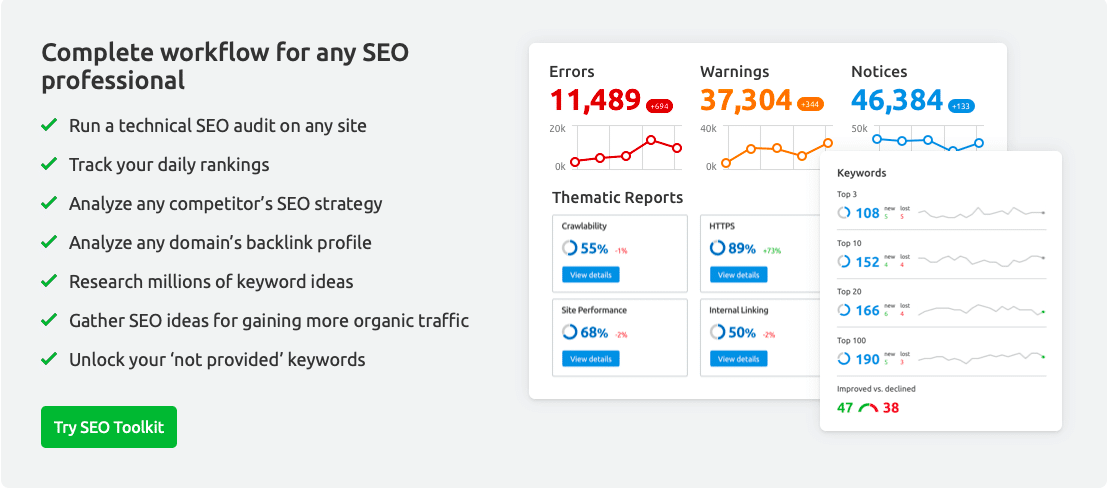
- Market Explorer: It reveals your target audience.
- SEO Rank Tracker: It lets you know the daily progress and changes in the rankings of a website or campaign.
- Traffic Analytics: It gives you a peep at your competitors’ traffic.
- Backlink Audit Tool: It lets you detect and eliminate toxic backlinks. At the same time, you can detect good sites to get backlinks.
- Terrific amalgamation of Google Search Console and Google Analytics.
- SEO writing assistant: It analyzes if the content is original and has SEO potential.
- It conducts competitor research to extract the best keywords for you.
- Its keyword research supports long-tail keywords.
- It provides advertising research, which includes relevant keywords for your advertising campaign and ad budgets.
- PPC tools and social media tools.
Start your SEMrush trial today!
Most-loved features of Ahrefs
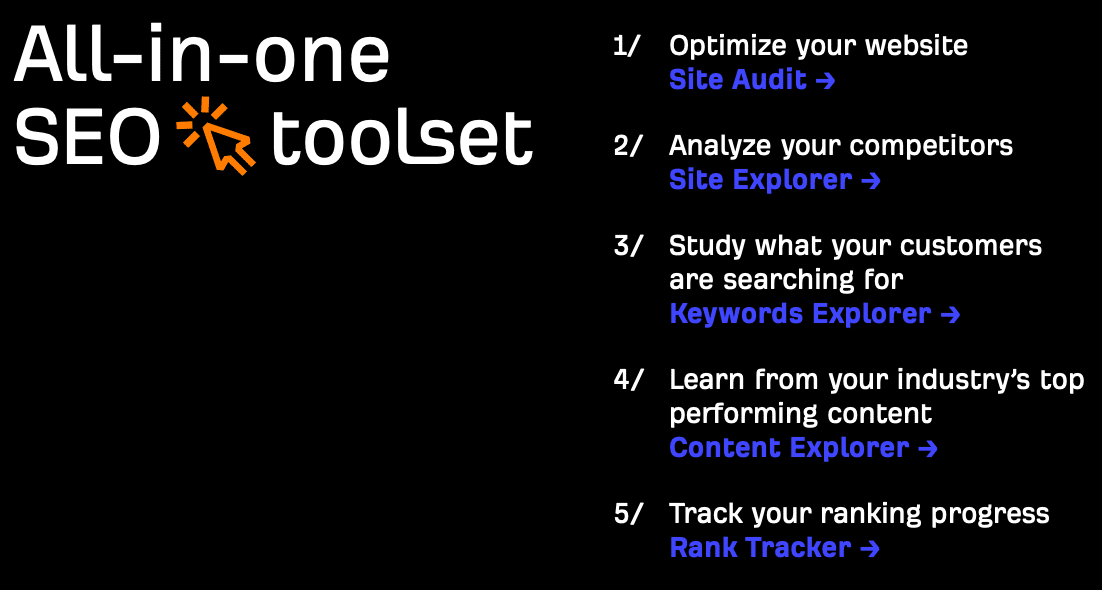
- Content Explorer: It gives the best topic suggestions.
- It offers customizable alerts for new keywords, backlinks, and others.
- Site Explorer: It provides a deep insight into search traffic.
- Intuitive interface: It reveals your search engine ranking and your website’s general “health.”
- Site audit and JavaScript Rendering: It helps you find SEO issues.
- Reports with charts.
- Domain Comparisons.
Aren’t the features of both SEO tools impressive?
Well, it still doesn’t answer the question: what SEO tool to choose? In fact, both the tools sound so impressive it becomes even more confusing to choose one!
So, let’s do an in-depth comparison of both these tools to make it easier to choose between the two.
Comparisons
1. Dashboard comparison
SEMrush dashboard
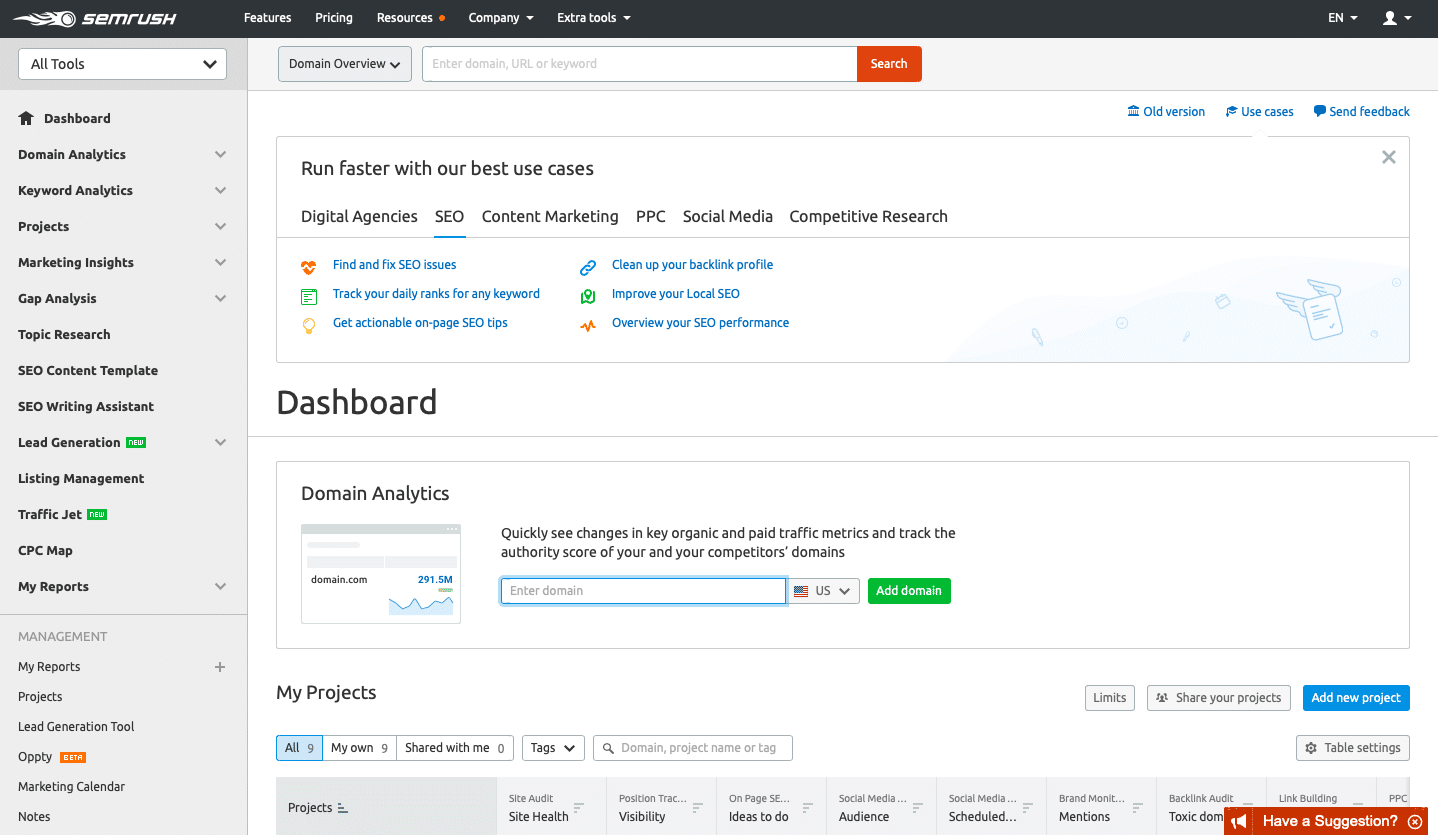
Log into SEMrush and you are greeted with essential tools like search bar, menu, customer support, info about your organic and ad keywords, site traffic, and domain analysis.
You can type a keyword or domain or anything you wish to explore in the search bar. The menu, located on the left, features quick links to keyword analytics, projects, and others.
The customer support is right there on the dashboard, so you can chat with the team. Other resources are blogs, webinars, and more. They come with descriptions; so a beginner, who may not know acronyms yet, can easily use the dashboard without getting puzzled.
Ahrefs dashboard
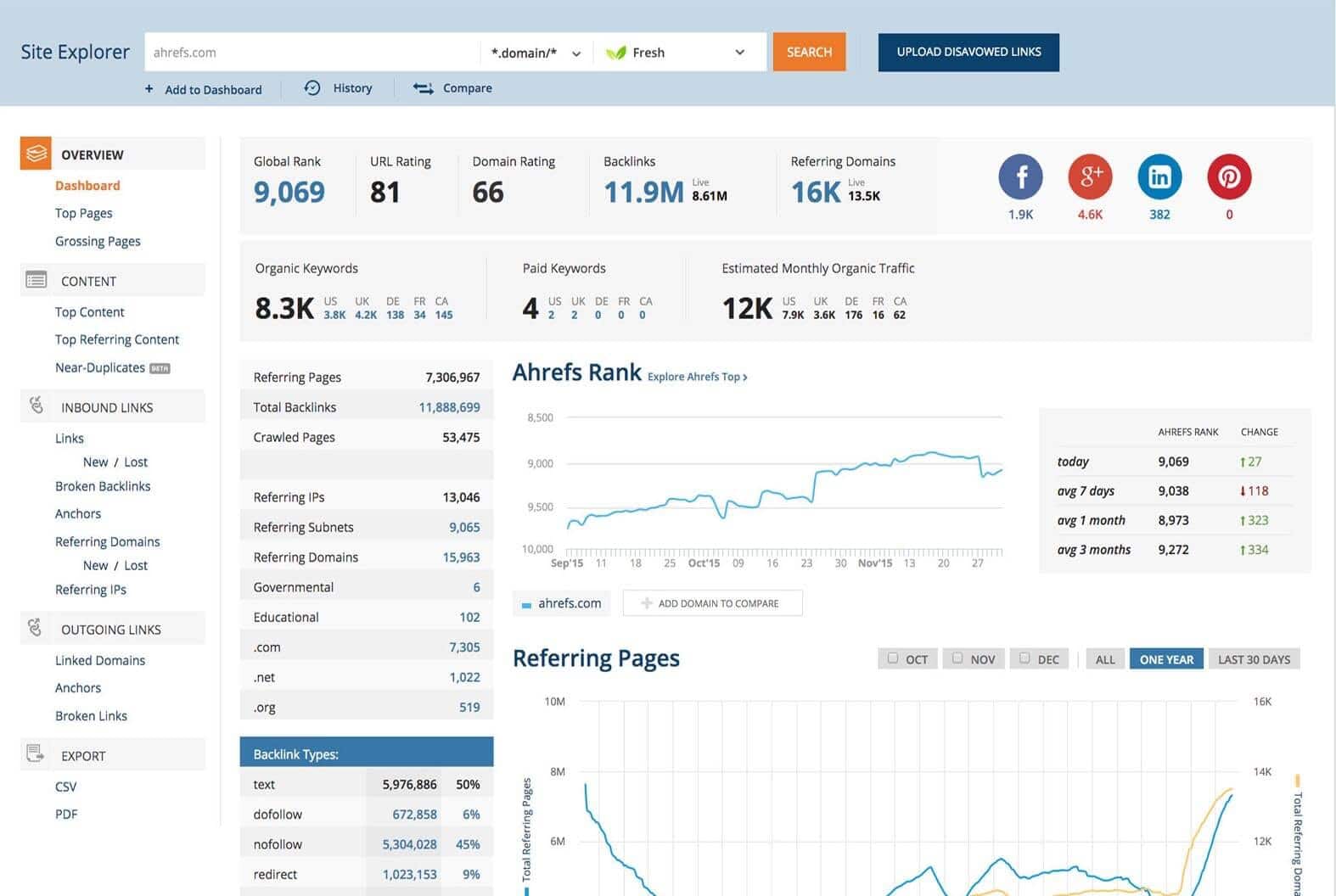
Ahrefs has a cleaner dashboard. You will find the primary menu at the top. Its search bar is only for typing in the domains.
It is easy to go from one tool to another. As you use its Keyword Explorer to search for a keyword, just one click can send you directly to the rank tracker.
Can’t understand something? The tooltip helper gives you an explanation.
The dashboard also provides analytics like domain ratings, backlinks, search engine rankings, and others.
The winner
The dashboards of both these SEO platforms are similar in the sense that they offer analytics and reports right there in the front.
If you like to keep things simple: Ahrefs is the winner for its simple and clean interface.
If you like to have everything in the “starters plate,” SEMrush is the winner. Its dashboard, while appearing cluttered, gives you almost everything at the start, including customer support.
So, there you go. The dashboard choice depends on your personal preference.
One thing to note here is: SEMrush allows you to start your research quicker through immediate access to the dashboard. On the other hand, Ahrefs demands a little bit of configuration at first.
2. Keyword comparison
SEMrush keyword research
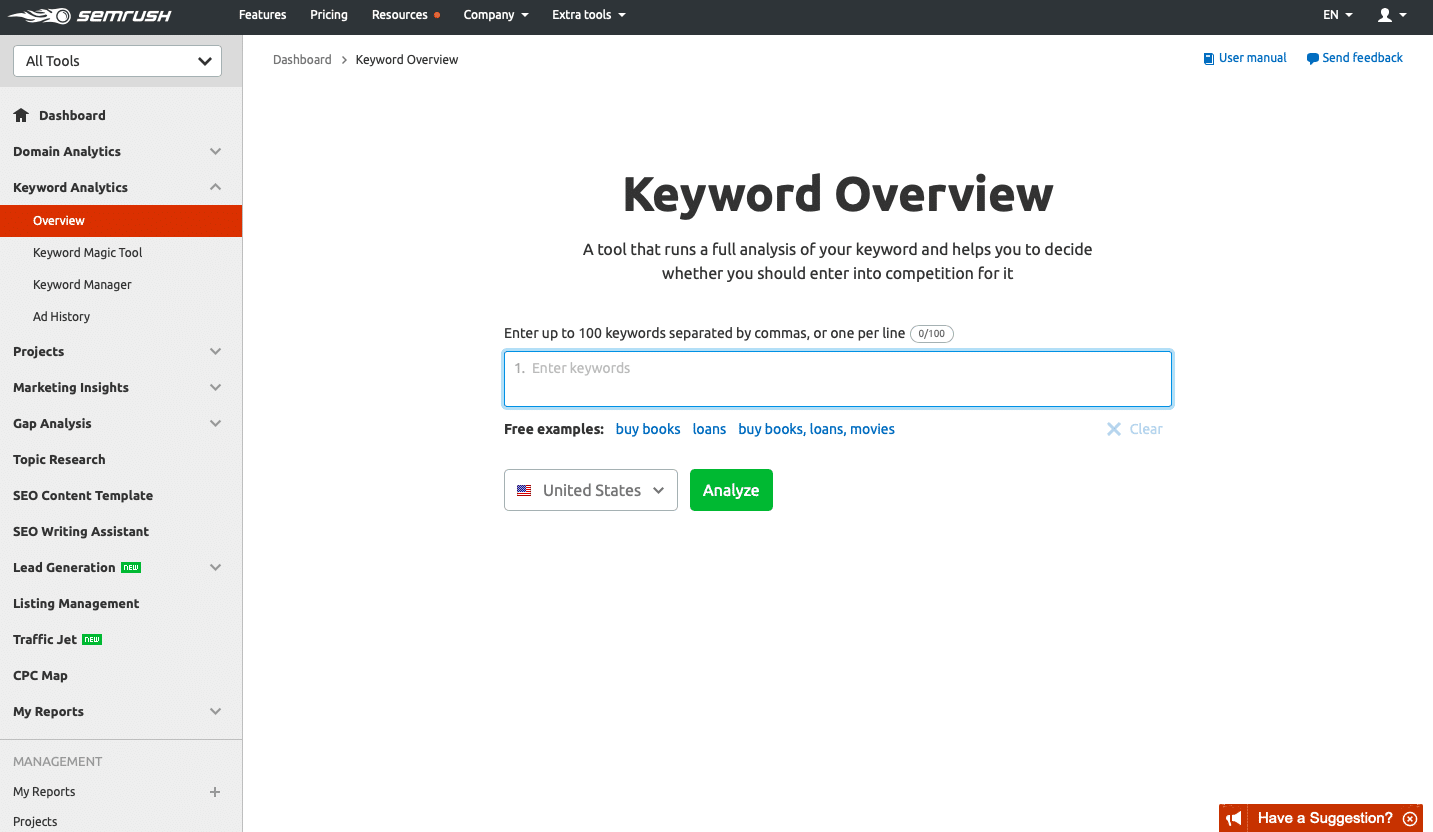
SEMrush offers Keyword Magic Tool with a whopping 18 billion+ keywords for the search engine Google! Enter in any keyword for analysis and you will get a comprehensive list of keyword suggestions.
You can also:
- Search exact matches of keywords.
- Check keyword performance metrics.
- Check data such as keyword trends, search volume, cost per click, and keyword difficulty.
- Its Keyword Overview feature lets you enter multiple keywords simultaneously and also analyze them at a time.
Start your SEMrush trial today!
Ahrefs Keyword research
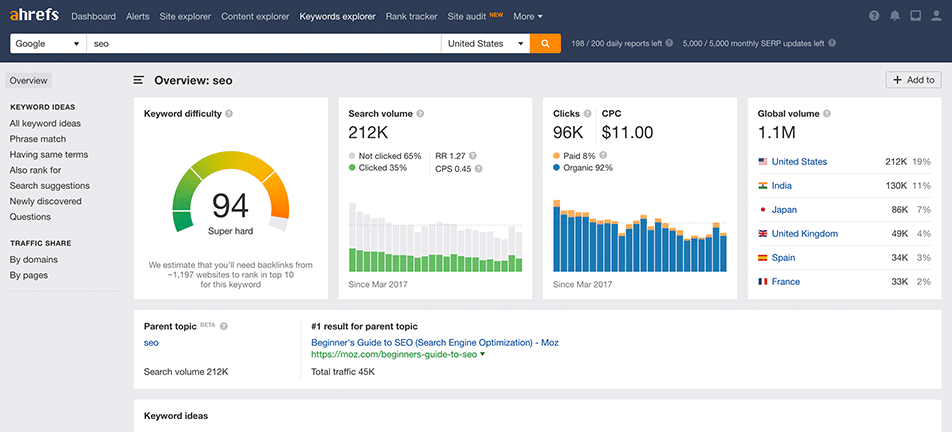
Ahrefs offers Keyword Explorer with innumerable keyword ideas. The platform lets you conduct targeted keyword searches. It also has a feature similar to SEMrush’s Keyword Overview.
You can also:
- Search for keywords on various search engines like Amazon, Yahoo, Google, Baidu, Seznam, Yandex, Naver, Daum, Bing, and YouTube.
- Get keyword search volume and difficulty by clicking on potential keywords, plus find keyword suggestions and other options that you may have not known before.
The winner
SEMrush is the winner in keyword research because it gives more keyword suggestions and alternatives than Ahrefs.
3. Rank tracking
SEMrush rank tracking
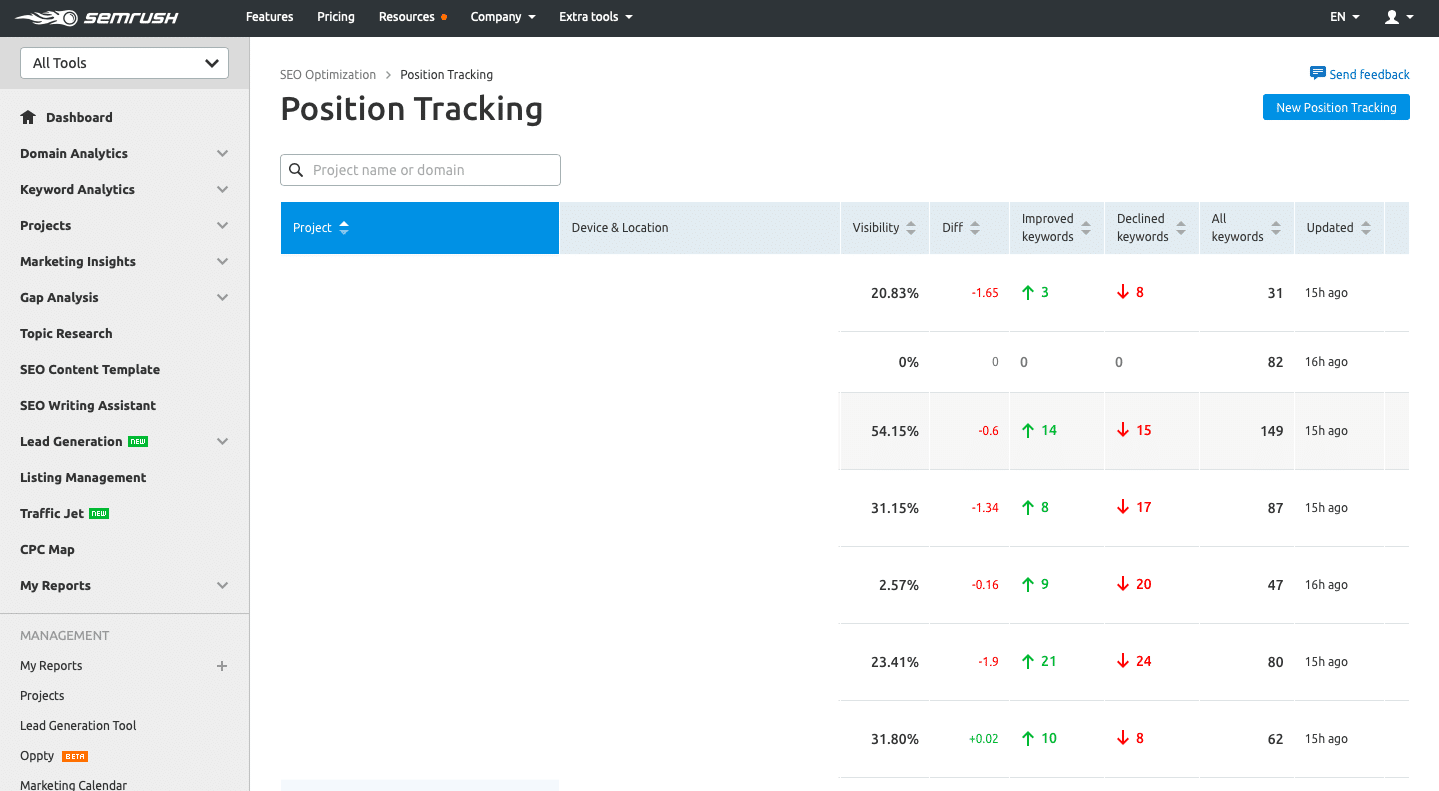
SEMrush offers the Position Tracking tool. It gives you daily updates of data and mobile rankings. You subscribe for the tool and you get these by default. You also get intuitive reports and SERP features like Local Pack Tracking.
Ahrefs rank tracking
![]()
Ahrefs offers Rank Tracker that sees how your ranks are for particular keywords. You get results for traffic, visibility, keyword difficulty, and average position. You can enter the keyword difficulty area and check whether a particular keyword is worth using or skipping.
The winner
SEMrush is the winner because it gives you updated rankings and mobile rankings on day-to-day basis. It also gives social ranking analytics, which is absent in Ahrefs.
Although Ahrefs has an easier to use tool that takes just seconds to type keywords, an ambitious digital marketer may want to squeeze more of a rank tracking tool. In this case, SEMrush wins.
4. Analyzing competition
SEMrush competition analysis
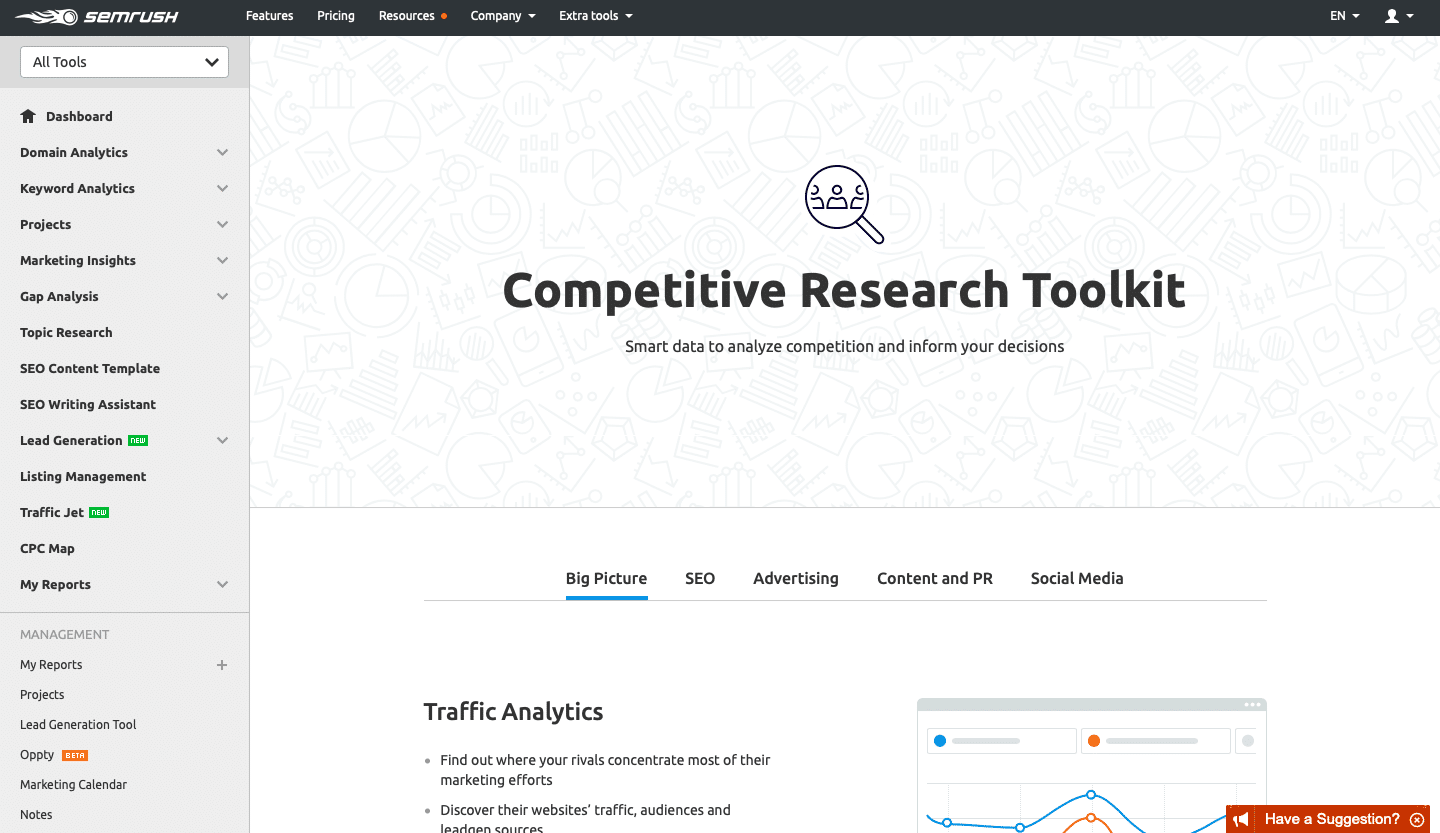
SEMrush provides multiple and efficient tools to “peep” at your competition. Here they are:
- Market Explorer: This search bar lets you enter a domain and list articles or websites similar to yours. You can then track the sources and do an in-depth analysis.
- Organic Research: It reveals leading organic search competitors, what keywords generate their traffic, whether they show SERP rankings, and others.
- Traffic Analytics: It lets you see the source of a website’s traffic, preferences of visitors in the use of devices, visitor behavior and what interests them on the site, overlapping of audience of multiple websites, and lots more.
Ahrefs competition analysis
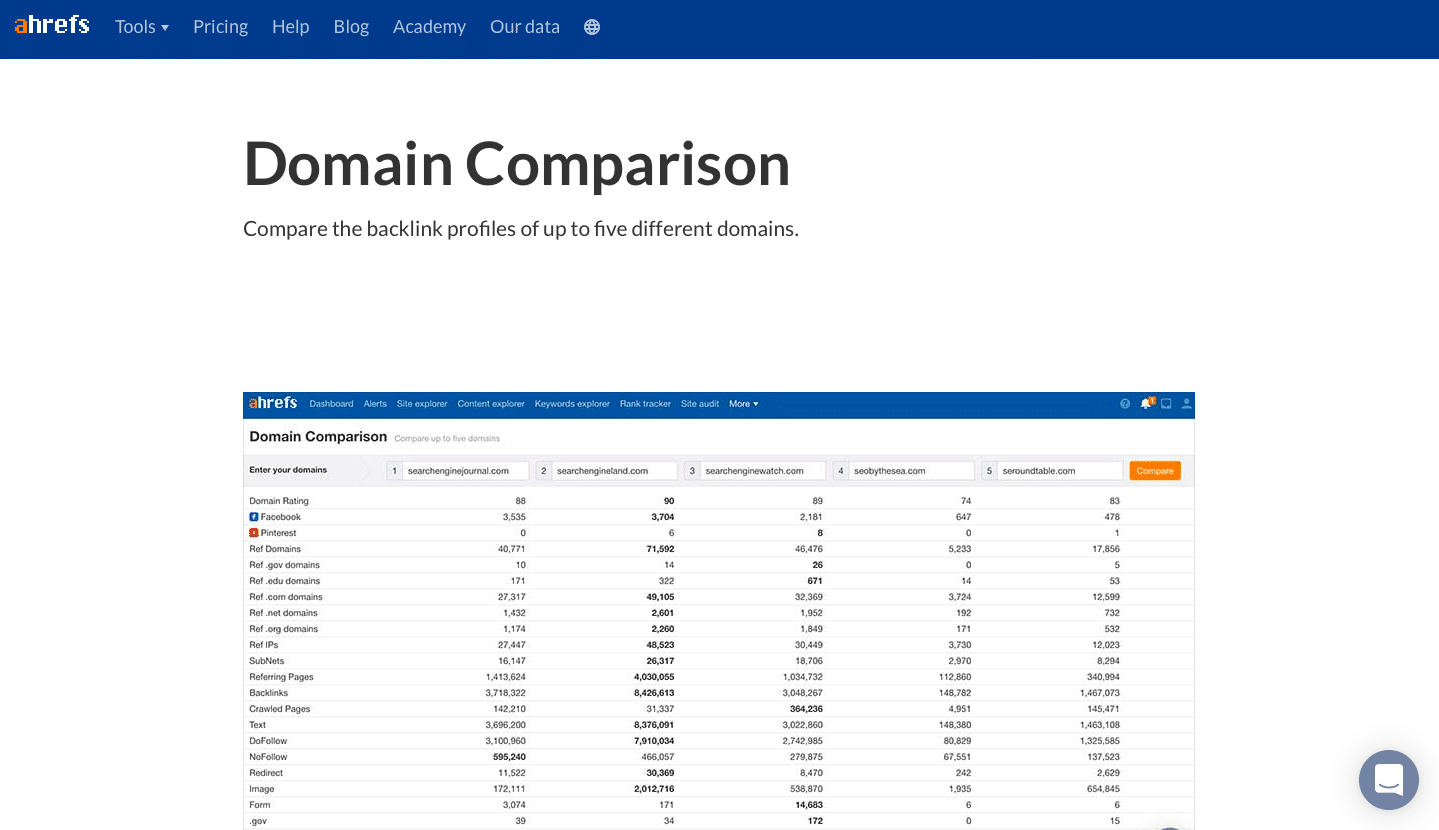
Ahrefs provides a domain comparison tool.
- You can enter a maximum of five websites here (your own and four of your competitors’). Then, you can compare them at one go.
- The platform’s Competing Domains tool lets you know your closest competition, plus a keyword intersection chart.
- You can navigate back to Content Explorer and Site Explorer and type your competitor’s URL for more information.
- You can have an overall view of your website’s performance in comparison with others, plus have a look at domain ratings and backlinks.
The winner
SEMrush wins again! It gives you more tools for analyzing your competition. Ahrefs is close to SEMrush in this case, but you need to use a combo of tools on this platform to get a clear picture of your competition.
Start your SEMrush trial today!
Conclusion

It, no doubt, is a tricky affair choosing between SEMrush and Ahrefs. Both are highly competitive and popular SEO tools. They possess their unique features and similarities.
It’s like comparing an orange to an apple. Both are highly nutritious fruits and beneficial to health, but each has its own unique qualities.
The choice depends on your need and personal preferences.
The choice
If you like spice in life, choose SEMrush. It is dotted with features for SEO and marketing, gives you an ocean of keyword suggestions, and keeps a closer eye on the competition.
If you like to keep life as simple as possible, choose Ahrefs. Its cleaner interface and simpler keyword suggestions can win your heart.
But, hey, doesn’t being too simple make you miss on the thrills of life?
The choice still is yours!
Panda, Penguin, Hummingbird. Do these names ring a bell? If yes, then you are a person fairly updated on what’s happening on the SEO front.
Keeping pace with Google algorithm updates have now become a way of life for digital marketers. Every time a new update is announced, they get down to restructuring websites for clients almost instinctively, knowing well that if they don’t, the rankings might plunge southwards and set off a series of events that can adversely affect current business and future prospects.
Those who have been keeping a close watch on these updates and related developments say that one aspect that has not changed much despite all the updates is on-page SEO. This, despite the fact that every on-page SEO task is aimed at benefitting the end-user.
[bctt tweet="The extent of engagement of a user when they visit your web page is the indicator of its value." username="relevance"]
The more time they spend there, the greater is the value of that web page.
This on-page SEO cheatsheet aims to help you understand the core factors that one must focus on for better results. When done right, the takeaways are better rankings, enhanced search traffic, and the other positive offshoots of these benefits.
So what are the factors you should focus on?
Creating Content That Drives Search Traffic

“When we create something, we think, ‘Will our customers thank us for this?” – Ann Handley
All those groundbreaking technologies and jazzy tools have not been able to dislodge content as the most vital factor for any business. But merely offering quality content is not enough. Successful content marketing involves publishing relevant content that has the power to drive the right traffic. Keywords are of course important but you can create a powerful impact by using specific keyword phrase components constructed using long-tail anchor words.
[bctt tweet="A surge in traffic can be expected when you start creating content using very specific keywords." username="relevance"]
Long-tail searches from customers or readers indicate a sense of urgency and a need to search for the exact thing they are looking for. Traffic emerging from such searches can enhance your stature among search engines because your content will be viewed as something that aims to solve problems by offering the right solutions.
You must aim to create content that is:
- Practical and valuable
- Offers interesting insights
- Aware of what’s going on in the user’s mind
- Easy to share
- Optimized
- Created to solve problems of readers
Custom content attracts readers and helps create a sense of deep trust and reliability. That’s why experts say that such in-depth and meaningful content is what companies should focus on to achieve their digital marketing objectives. What the reputed B2B marketing strategist said about content merits recall here:
“Content is the reason search began in the first place.”
Leveraging The Power of Meta Tags
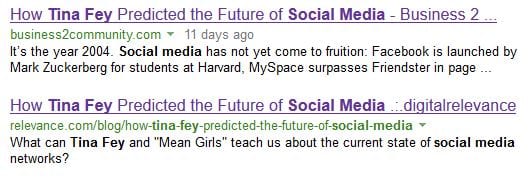
Over the years, Meta tags, and the way they are used has undergone major changes. Many might think that they have lost some punch but Meta Tags still can play a key role in on-page SEO. Let’s find out how to use Meta Tags to make your content search engine friendly.
Title Tags are synonymous with the title of your web page as they offer previews that can help readers make a decision. Use short and descriptive titles that are different from the content on the page.
Meta Descriptions are used by search engines to identify the context of your content so that it can be connected to the relevant audience. There are a couple of things you must remember while writing Meta descriptions.
- Keep it short and relevant
- Avoid stuffing keywords
- On-page SEO can be improved by using Latent Semantic Indexing
Focusing On Boosting Site Speed

The speed at which a visitor gets to read the content on a website is one of the key metrics of SEO and a huge indicator of the user’s experience. You can always run a check on what your site speed is using one of the numerous tools easily available online for the purpose. However, site speed score often simplifies things more than it should probably do creating a false sense of security.
In any case, measuring speed is a tricky thing because you must first know what you are measuring and what the best possible reading for that particular matrix is so that corrective actions can be taken if needed.
“Just because you can measure everything doesn’t mean that you should.” – W. Edward Deming
It is important to understand that Google will only penalize websites that are excruciatingly slow. Site speed is more important from a user perspective. That’s why site speed must be optimized based on user experience. But yes, slow site speed can affect businesses such as ecommerce stores.
[bctt tweet="For a good on-page SEO experience, site speed matters as it affects rankings." username="relevance"]
Site speed can vary when the same website is accessed from a desktop and a mobile device. Any speed check that you run must show the site speed of your page in the ‘excellent’ range for all devices.
Does the site speed show a lower than the desired result? You can easily resolve the problem by using search engine content delivery networks. You might have to spend some money but it will pay you great dividends sooner than later.
Code Optimization and Others On-Site Technical

This is a technical thing but if this can be done, it can help achieve your on-page SEO objectives.
Here’s what you should be doing:
- Make sure all JavaScript to be placed bottom of the page remains there
- Use canonicals where needed. Use a canonical tag in your header point out the original page that should be considered for ranking to Google if there is a duplicate page too.
- Add title tags to href tags and use descriptions to describe the same.
- An obvious thing to do is to make your website responsive and mobile-friendly (Believe me, some people still need reminders on this!)
- The site map submitted to Google must be updated frequently
Great on-page is a fine combination of understanding of the needs of customers and trying to solve the problems they generally face and doing accurate keyword research with the best available tools. Some reverse engineer tricks can help you find the exact keywords your customers are using. Your content must be crafted using these vital inputs to achieve a rich, high-value, and informative article that can resonate with your readers.
Loss of keywords and data is a common mishap that often happens during website development processes but it is important to realize that all is not lost all the time. Recovery can happen in most cases if you follow specific methods and use the recommended advanced recovery tools and methodologies.
If the keywords that are driving your traffic is not to be found or if your website ranking is plunging southwards for no apparent reason, you must take immediate corrective steps to restore normalcy. There are a few ways of doing this but the most important thing to do at this juncture is to accurately identify the keywords or the pages that fell.
To be able to do this, you must know which keywords responsible for driving traffic and how it impacted the overall ratings of your website. The drop of a keyword or its variation can be a major setback. Here’s what you can do to set the repair task rolling.
The 2 Key Tools To Your Rescue

Google Console Search and Google Analytics are the two key tools that can come to your rescue in such situations. We will start with Google Analytics.
Begin with the Acquisition tab and go to Overview and Organic Search. Select Landing Page and then choose the Conversion Item from the drop-down list that shows up at this stage. When you set the Secondary Dimension to Acquisition and Source, you can filter the pages by Google in a convenient manner.
You must have a fair idea of the date around which you lost the keywords as there is a date range field to be filled. You can also choose a comparison period option.
After you have done this, go to Google Search Console and then to Performance and Pages. Enter the date range or the comparison dates you had earlier set.
Look for the page that got an increase in conversions and search for the same in Google Search Console. You will get a list of keywords and the date they started ranking on Google. You can easily find conversion and traffic gains/losses data here.
Make a Proper Diagnosis

Now that you have covered the first critical part of the analysis, let’s come to the other equally important part and that is diagnosing the problem. It is imperative to find out what caused the pages to fall or why the keywords were lost. This could have happened because of various reasons. By identifying the exact cause, you can ensure that you don’t suffer the same hassles in the future.
Diagnosing the cause of lost keywords is not easy as every website has its own specific issues. However, there are some guidelines that can serve as a starting point. You can get a fair idea of what the reasons are by looking at these points.
- Where was the traffic coming from?
- Is your content appearing as stale now?
- Was there at attack launched from any of the links pointing to your page/website?
- Was the loss limited to single page traffic or was it deeper (Whole website/few categories)
- Are other keywords still driving traffic to the page?
You will also have to find out other details like page speed, content quality, and user experience of the pages that show up for the main keywords and phrases.
Hacking of your website could also be the reason for losing keywords and pages? Check if your website was compromised and if yes, what was the impact. Another possible reason could be poor link building strategies. If you are not careful and do not take a measured approach to link building, it can affect the security of your website and web pages adversely.
Some of the high-risk areas that can result in the building of bad links are:
- The network of private and possibly fraudulent bloggers
- Paid links
- Banner ads and advertisements that run on the website
- Badges and certificates
It is equally important to run a few checks on your website to detect any changes in the website layout. At times, it becomes necessary to optimize more media types to gain ranking.
Have You Migrated To A New Server?

Migrating to a new server can also result in a possible loss of keywords and pages. To avoid this, it is important to have a proper redirect plan. The same applies when you carry out any structural changes to your website. Links, tags, and XML sitemaps must be updated to prevent any drop in rankings.
Please remember that search engines will be indexing everything including your old and new websites. If you do not have a proper redirect plan in place, it is very likely that you will get penalized for duplicate content.
Are You Being Penalized By Google?

A sure sign that your website is suffering from a Google penalty is when your site experiences a drop in rankings on Google but continues to have a steady ranking on other major websites. The penalty must be removed and the problem fixed and the best way to get started is the Google Search Console account.
You can start with the notifications from Google or any warnings in the menu message. Google will share details of how and where the compliance with their guidelines has been tinkered with. Not only that, but you will also be offered solutions on how to fix the problem.
Other Reasons
Sometimes, the drop in search engine rankings is not due to any of the above-mentioned reasons or the outcome of anything associated with the website. Google makes some changes to the search engine results based on user behavior in specific areas and topics. Such changes may affect your rankings, especially if your content is static and has not been updated recently.
Are you experiencing a dip in ranking and loss of traffic despite doing everything right? You can be almost sure that your competitors have decoded your strategy and have managed to be one-up on you. The right way to overcome this problem is to go into deep analyzing and monitoring mode and get a deeper understanding of the social media strategy, link building techniques, and content marketing strategy of your competitors.
Conclusion
It is important to note that there is no quick-fix way of increasing your website traffic and improving search engine rankings. The strategy to fix the problem must be arrived at by making a proper diagnosis and identifying the reasons why you are suffering a dip in ranking or losing pages. Keep an ear to the ground so that you remain current with the latest developments and best practices that can boost your visibility online and help you achieve your goals.
The COVID-19 crisis has affected nearly every business across diverse sectors. While some have barely managed to keep their head above the water, many have sunk to such depths where resurrection looks nearly impossible even as the coronavirus continues its relentless spread.
With conventional stores and outlets out of bounds for consumers and even the ones that operate on a skeletal staff and staggered timings not getting footfalls as everyone wants to play safe, consumers are turning to eCommerce in a big way. They don’t have any other option, do they? Ecommerce, safe-distance pickups, and home delivery have become the new normal as the world struggles to deal with the challenges created by the pandemic.
Here are some interesting stats from research conducted in March when the coronavirus truly started picking up pace.
- 95% of consumers are now avoiding public places.
- Media consumption is exploding with video consumption and streamed content reaching whopping heights
- A large number of consumers now log into their social media accounts daily
Online search is an activity that almost anyone with a browsing device and an internet connection is indulging in and for a large percentage of their spare time which constitutes nearly the whole day in today’s changing scenario. With the market shifting to online options, companies are forced to optimize their resources. They are looking at ways of providing their consumers with the information they are looking for in the best possible manner.
Experts believe that the post-pandemic SEO agencies will have to take a completely different approach that will be significantly different from how they operated before the global health crisis was unleashed.
The insights that SEO provides to online businesses about consumers and their behavior can come in handy in these times of volatility and fluctuating demand. Professional SEO advice can help companies manage uncertain market conditions, protect their brand name, and ensure the right positioning of their products and services to maximize output.
Experiences from the past show that many companies have been able to survive the impact of recessions caused by such global situations by making suitable changes to their marketing strategies. While it is not going to be a walk in the garden, the very fact that it is doable provides a huge sense of relief.
Here are some of the key SEO innovation strategies adopted by companies to beat the crisis foisted by the pandemic:
Dump Long Term. Think Short Term
With most clients struggling to keep their business afloat, it is commonsense not to have a long-term strategy in place. To have a better impact, think about now and the near future. Innovation is the need of the hour.
Marketing is such times is a huge challenge and you need an out-of-the-box approach to remain profitable as there are cash flow strains everywhere.
There is no business-as-usual situation in any industry and that’s why there is a need to tread with utmost caution.
Spend More Time and Resources on Research and Communication
The best SEO move in such times would be to invest in research and go after real-time data on customer demands. It is equally important to have a greater level of engagement with clients so that you can remain updated with the latest developments and also get their valuable input on critical matters which can help in shaping an impactful SEO strategy.
Track Developments On A Weekly Basis
SEO companies will do well to create personalized dashboards for individual clients so that their business performance can be tracked on a regular basis with a great degree of accuracy. This will help them access the necessary feedback and make any fine-tuning if needed. Tracking will also help in keeping a close watch on the trends prevailing in the industry in the changing circumstances and creating solutions based on emerging situations.
Provide More Alternatives
Extraordinary situations demand extraordinary approaches and unique solutions. The pandemic has created a marketplace where your tried-and-tested strategies are unlikely to yield results. A different approach entails deeper and more expansive research which in turn means more investment and sharper marketing brains. Creating strategies that add more value to the marketing outcome is the need of the hour. This must be done keeping in mind the budget constraints of the clients as money is no longer flowing as freely as it probably did in normal times. To create unique SEO solutions, marketers must:
- Look for newer tools
- Explore wider geographies
- Create highly targeted campaigns based on the current trends and future possibilities
Most parts of the world have been under lockdown since early March but administrators are realizing that they need to find a better way of dealing with the pandemic. That’s why we see many parts of the globe coming out of the quarantine in a phased manner.
Data-Driven Innovation
SEO agencies will have to find new tools and software to generate data and delve deeper into business operations to find insights that can help craft high-level strategies. Proactivity is the need of time - not only in finding potential problems but also in offering creative solutions. Reinvention is necessary in every stage of the business process to deal with the unique situations and times we all are in today.
Boost Your Local to Global Reach
Consumers are all going online for their buying needs as the conventional purchase resources are out of bounds, mostly. Most of them are using search right now to find supply sources. Are you positioned in the right manner to appear in those searches? SEO companies are advising businesses to optimize existing content for their specific region, area, or city. This is the best opportunity for businesses to strengthen their local market and also attempt a global outreach by setting up a franchise.
It is difficult to predict when the current lockdown and restrictions will end or relax given the fact that coronavirus continues to impact lives and normal times seem like a far-fetched dream now. For businesses, SEO is a great way of understanding the needs of customers and ensuring that appropriate responses are provided.
If you are either preparing to launch a new website or if you have already launched, there are quite a few important steps that you can take in order to proactively boost your SEO performance from day one (and earlier, in some cases). Take a look below at a few of the ways that you can help improve your SEO performance from launch day forward. Launching a new site is a great way to reach new potential customers, help to drive new traffic, and ultimately increase your business, but like anything, you will need to take steps to make it happen and stay diligent along the way.
Take a look below at some important ways that you can improve your SEO on your new website, and leave us any additional tips or tricks that you have found helpful in the comments.
Hire an SEO Company
This might seem like a bit of a non-tip, but hiring an SEO company is a failsafe way to ensure that your SEO strategy gets the attention that it deserves from an experienced and dedicated team of specialists. You are busy running your own business, and if your strategy works then you will be fielding new inquiries, so it might make the most sense to hand off this specific marketing effort to a pro.
Install Analytics Tools
Google and Bing both offer very useful tools such as Google Analytics, Google Search Console, and Bing Webmaster Tools that will give you granular, detailed information about how your website is performing and gives you insight into what you can change to improve performance. Without useful performance metrics, you are left making SEO decisions by feel, which is another way to say “wasting your time.”
Create a Content Calendar
All too often, a company launches a new website and is enthusiastic about maintaining a blog, reaching new users, and providing ongoing updated content. The reality is often quite different. After a few blog posts, it can be easy to skip on here and there, then skip a few, and all of a sudden your last post is from 6 months ago. By creating a calendar, complete with post topics, you can hold yourself accountable and continue to put out useful content.
Check Your Titles and Tags
Launching a website and forgetting to make sure that your meta tags, titles, alt tags, and descriptions are all in-line with your SEO keywords strategy is an easy mistake to make, and one that will have serious impacts on your search page rankings. Search engine crawlers use these tags as indicators for the overall content of your site, in addition to analyzing the content itself. Missing tags or titles indicates a careless site manager, which may indicate that Google is better off sending their users to another page.
Optimize For Load Times
One of the easiest ways to get bumped down in the search results page is to have a page that loads slowly. There are a lot of different reasons for a site to load slowly, including the siren song of extra plugins, autoplaying videos on your homepage, and cramming full-resolution images onto your page without first compressing them. Each of these will cause your site to load slower, and for the search engines to dock you valuable points for where you land on the search results pages.
Is there are word count system that can be leveraged to gain high ranking on search engines? Does SEO take into account the length of an article? Is there a connection between word count and SEO at all or is it a myth? Let’s find out.
Content marketers and writers do have to confront this puzzle quite often - What is the ideal length of an article in terms of words and paragraphs?
Long Copy = Deep Research? Not Quite!
Yes, the length is an important factor and often puts other aspects into the background such as the core purpose of the copy, the intent of the content, and the audience it needs to address. For some reason, nearly every conversation with a client begins with word count and page length. Is it because of the popular belief that longer articles rank better? Do search engines believe that pages and pages of content indicate exhaustive and deep research entailing long hours of hard work that deserves a high ranking?
You have to agree that there is a strong belief among many people that a longer copy makes the content more rank-worthy. What can this misconception be attributed to?
Content marketing experts point out the presence of numerous studies around the word count subject but none of them provide any firm closure to the debate in the real sense. There are a lot of loose ends which means the confusion persists.
Relevance Matters More Than The Length
Many factors come into play while determining the right length of the content but the ranking of a page is not driven by its length alone. The objective of a page and its contents should be to provide the necessary information required by the visitor to achieve their objective of visiting that specific page.
In some cases, all they might need is a quick, crisp answer to a particular query and in other cases, they might require a detailed and in-depth explanation about a particular topic or subject. Going by this reasoning, the length of a content page does not hold as much importance as the quality and relevance of the information provided.
Google has made it implicitly clear that the needs of the user must take topmost priority and must be adequately addressed before anything else.
The focus should be on assisting the human visitor and not on supporting a search bot.
Is There a Proven Word Count for Best SEO?

If you believe that there is some formula by which search engine ranks an article based on its length then let it be clear that there is none. There are no Google guidelines that a specific number of words must be used for an article or page to rank high. The search engine algorithm is simply designed to rank pages based on its ability to satisfy the query of a user. There is no such rule that a content page with 2000 plus words will rank on the top search pages of Google, guaranteed! No.
Word count or volume is rarely a deciding factor according to many experts.
[bctt tweet="The number of words of a copy is, without a doubt, the wrong way to measure its utility to the readers." username="relevance"]
This has been confirmed by none other than John Mueller, Senior Webmaster Trends Analyst at Google in one of his tweets some time back.
“Word count is not indicative of quality. Some pages have lots of words but say nothing. Some pages have very few words that are very important and relevant to queries. You know your content best (hopefully) and can decide whether it needs the details.”
There is also this trend of piling on words on a content page simply because your top-ranking competitor did it. Some marketers fear that they will be seen as providing lesser information if they do not match the same word count and page length as that of their competitors.
This again is not true! John tweets to set the record straight:
“Having the same word count as a top ranking article is not going to make your pages rank first, just like having a bunch of USB chargers isn’t going to get you to the moon. But, I’m still tempted to buy some of those USB chargers.”
Correlation Between Word Count and Ranking - Is There Any?
However, despite reassurances coming from the right places, a lot of people still believe that there is a correlation between word count and ranking. For instance, it the content length of the top pages for a specific search term is around 2,000 and more, they would see it as a definite sign that any page that has less than 2,000 words will not be considered for top ranking.
While this is understandable, it is definitely not the truth. The longer pages might be ranking well but the length of the content has nothing to do with the rank.
It is the quality of the content and its relevance on these that’s making these pages soar high on the search engine rankings.
It is also possible that it is the link profile of these pages that are driving its rankings.
What Determines the Length of a Copy

Logically speaking, the length of content should be directly proportional to the subject matter and the query it aims to address. Shorter content will do better than longer ones in places where there is no need to stretch the pages. For instance:
For content that seeks to address the query such as the metro station near me will be significantly less than that which addresses the question about the history of Wimbledon.
“Content should be factually accurate, clearly written, and comprehensive.” – Google’s SEO starter guide accurately captures the picture.
To make it more clear, comprehensive here means complete. The content should include everything necessary to address its core purpose. At the same time, it should be free of fluff and inane sentences and descriptions which hardly adds any value to the overall content.
Marketers have come up with a really practical explanation of why content must not be built around a fixed word count. A piece with a suggested word count runs the risk of becoming diluted and straying away from its stated objective. It may be assumed in such cases that the writer will try to fill the paragraphs and pages with a random volume of words with the sole purpose of reaching the word count, thus sacrificing the quality and crispiness of the content in the process.
Will that make a good reading material? Obviously no!
Will it provide the requisite information in the right manner? No again!
The Consequences of Fluffing:
- It affects the manner in which the copy will rank for the targeted keywords
- The keyword theming of the page will go astray with unwanted content making its way into the pages
- A page that was supposed to be crisp and relevant to the topic will lose its punch as other concepts are introduced to add to the length
- The ability of the page to rank for the targeted keywords may get severely affected
[bctt tweet="Word count should never be the target. Delivering the message home is what writers and marketers should aim for." username="relevance"]
Purpose Over Word Count
Ask yourself what is the real purpose of the page you intend to create. Is it intended to provide information? Is it created to encourage visitors to explore other pages on the site? Is it for performing some transactions? The purpose of the content page will decide the length of the content.
When you provide visitors reliable and accurate information based on the purpose for which they visit the page, you can achieve the objective of ranking higher than your competitors in organic search results.
User Intent

User intent is another factor that will decide the length of the content of the page. What is the user looking for while landing on a specific page? If you know the answer to this and create content (regardless of the length) to satisfy their needs, your page will be a winner by all counts. The visitor is a busy individual who is unlikely to have the time and the patience to browse through a length description when a relatively crispier one would more than suffice.
A note of caution here: Making a page long does not help the visitor who comes for a purpose. It is more important to serve that purpose and achieve better rankings. And when you do that remember one more thing. Search engine optimization is of course about ranking high but it is more about converting traffic. Remember that while writing the copy.
Copy Length and Conversion
Is there a connection between copy length affects conversion?
While it’s a proven fact that reams of text might be off-putting for readers in some context such as a product description page, other types of pages might necessitate long copies to help visitors achieve their objective and complete an action.
The clear verdict, therefore, is that there is no right word count or best word count for SEO.
[bctt tweet="Word count can never dictate a copy length, its objective should." username="relevance"]
The copy length should be such that it meets the needs of the user and also encourages conversion at the same time.
Some Interesting Research-Based Data
Here are some interesting observations based on extensive research of what the ideal length should be for various posts. Be warned that these are ideal representations based on the research of a large number of such posts and should not be viewed as the best practices. You can use these suggestions as a testing point for your posts wherever it is possible for you to use them.
Tweets:
Tweets with less than 100 characters have a higher engagement rate
Facebook:
Facebook posts of around 40 characters get a higher rate of engagement. Posts with more character count generally grab lesser eyeballs.
Paragraphs:
Opening paragraphs with around 40-55 words resonate better with readers.
URL Domains:
Short and easy-to-remember domain names work best. Limit it to 8 characters for easy recall.
Hashtags:
6 characters define the perfect hashtag according to research. Avoid using special characters, don’t start with digits and no slangs, please.
Subject Lines:
Subject lines get the best click rates if they contain around 39 characters.
Title Tags:
Limit your title tags to less than 60 characters; 55 is the ideal number.
Blog Headlines:
Are you surprised to learn that the first 3 and the last 3 words of a headline are usually read? Don’t worry about the length but 6 words headlines work best for blogs.
LinkedIn Posts:
Limit the posts to 16-25 words for business marketing and 21-25 words for consumer marketing. At least, that’s what the trend says.
Blog Posts:
Blog posts that can be read under 6 minutes have a better engagement rate than those that can be read under 3 minutes. The ideal word count? 1600!
YouTube:
After researching the top 50 YouTube videos, it was revealed that the short ones are more popular with the average length being under 3 minutes.
Podcasts:
Attention can be retained for around 20 minutes only and that’s why the average podcast length should be around 20-22 minutes.
SlideShare:
6 minutes is the best time length for SlideShare.
It is important to understand that the post lengths and word counts mentioned for various sites are based on research by diverse agencies and sources. What works for others may not deliver the exact same results for you. This is undoubtedly some valuable data and can be used as a reference point for your needs.
To wind up, here is one from John Mueller again:
“Some low quality pages are unsatisfying because they have a small amount of main content for the purpose of the page. For example, imagine an encyclopedia article with just a few paragraphs on a very broad topic such as World War II. Important: An unsatisfying amount of main content is a sufficient reason to give a page a low quality rating.”
The principles behind search engine optimization (SEO) make sense for businesses looking to capture target audience interest in a particular field, industry, or product type. For example, a consumer enters the phrase "brown spots in lawn" into the Google search bar, and multiple lawn services providers pop up. Their profiles feature content filled with tips and tricks as well as Google ads for useful products. This search result tactic works wonders for businesses with large audiences that address problems most everyone faces. But SEO also works well in niche markets, assuming it's leveraged correctly.
Obviously, some businesses don't have large audiences. How can SEO be as effective for them to target a potential customer? If you are operating within a niche business, read on. Learn how you can effectively leverage SEO for online success.
Understand Search Volume
Search volume is an important concern for SEO. It is essentially how many people are searching with the intent of finding and interacting with your niche.
No matter which SEO tool you use, researching search volume will give you a good idea of the size of your online audience. Scanning through Google Search Console, for example, you'll learn what terms your target audience are using to search for your industry or your business in particular.
The best way to research search volume is through Google's Keyword Planner, which you can access through your Ads Account. Here, you can find graphs pertaining to the popularity of different words and phrases used in the search. Because you are working within a niche, you are likely to discover that your search volume is low.
However, it shouldn't be non-existent.
If you do try to use a keyword phrase that is associated with little to no traffic on any search engine, the Google Keyword Planner should tell you that your keywords aren't contributing to SEO success.
Search intent is a bit different from keywords. While terms, phrases, and related keywords used in the search query factor into intent, they aren't always directly descriptive of what a web user wants in the search results.
Google is getting better at understanding and identifying intent through machine learning tools like BERT. Accordingly, you should try to work with search intent within your content to increase the number of keywords you rank for and boost your search volume.
- Related Article: Step by Step Guide to Keyword Research
Research Keyword Specificity
Usually, specific keyword phrases are better for SEO because there is less competition for them.
For instance, huge corporations tend to rank for "financial services," but smaller, local businesses have more opportunities to rank for "financial services Modesto CA." This is a great example of how to approach an SEO strategy in niche markets. Using local SEO and niche driven SEO allows smaller businesses to rise in ranking for a specified target audience.
However, there is a fine line between appropriately specific and obscure. You need to be careful not to cross that line. If you do, you'll lose whatever meager web traffic you can get.
Keyword research is difficult even at the best of times. Still, when you are trying to balance on the edge of specificity, you should consider hiring an SEO expert or marketing agency. Many specialists can provide SEO services such as keyword research, niche driven SEO, or technical SEO a la carte or provide a comprehensive package.
SEO agencies have the right keyword tools to help you track and choose the best terms and phrases to target, especially when your search volume is low, to begin with. They will start with a content audit and an SEO audit. They will conduct keyword research and help you assess your current domain rating. Plus, experienced SEOs know more about managing search engine intent with keywords.
Research Your Search Competition
It is likely that you operate within a smaller niche because you discovered a need and worked to fill it. You might be the only business of your kind. However, you will still probably have some sort of competition for your keywords. A cursory glance at your website's Google Analytics can help you see how your niche edit is performing.
To dominate in your chosen keyword categories and develop a content strategy, you first need to know what pages you are up against. The very best email marketing effort, blog post, or affiliate marketing campaign won't boost your domain authority if you are getting drowned out by your competitors. And yet you certainly don't want to waste time chasing every Google trend.
It's important to note that your competition might be firmly established in your industry. They might be ranking for your niche keywords for a completely unrelated reason. Regardless, you should look into their content and SEO tactics and work to best them in every way. Specific factors include domain speed and image quality to content quantity and relevance.
- Related Article: Why A Free SEO Tool Junkie Finally Joined The Paid Club
Develop Niche Content
Content creation is easily your most powerful tool in attracting a niche audience. The more content you have, and the higher quality it is, the better your link building will be and the higher your search ranking factor will be. That result is irrespective of the volume of searches coming your way.
You likely know your business and industry inside and out, so you can begin developing content and social media links for your target audience today. Right now.
However, creating your own content for the purpose of inbound marketing isn't a terrific long-term strategy. For one, lacking an outsider's perspective on your industry and products can be a hindrance to your business's ability to relate to and engage its audience.
For another, you might not have the time or skill to produce high-quality content on a schedule. Additionally, you might lack a network of publishers for the placement of your content to garner backlinks. Now or later, you should contract content marketing services. They will provide the expertise you need to execute your niche content properly.
It is more difficult to practice SEO within a niche market. You might quickly see your domain rise to the top of the search results. However, you might never obtain the huge influx of traffic that businesses in larger industries experience. Still, niche driven SEO remains an important digital marketing tactic. You should look into leveraging a niche marketing strategy for business success today.


